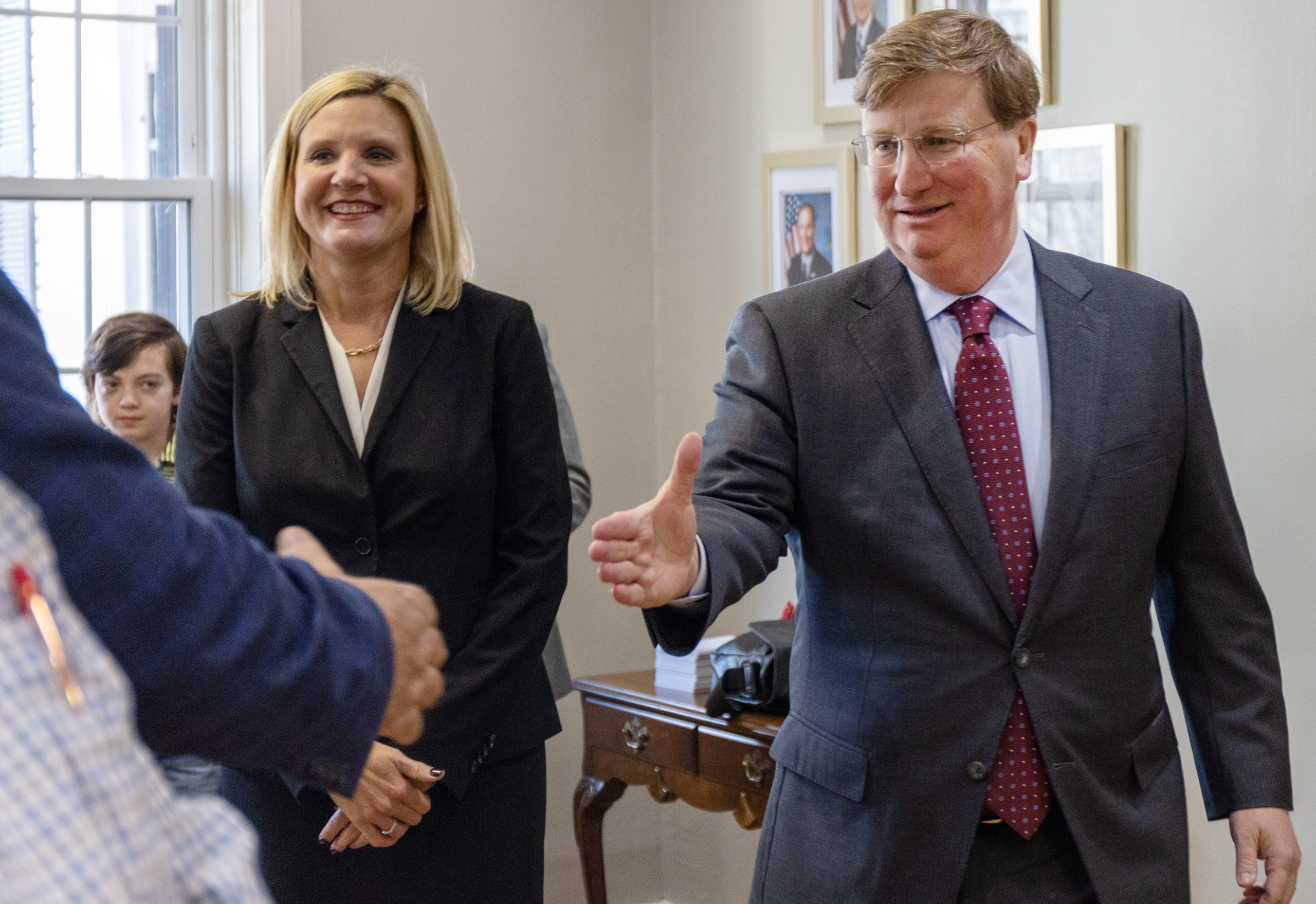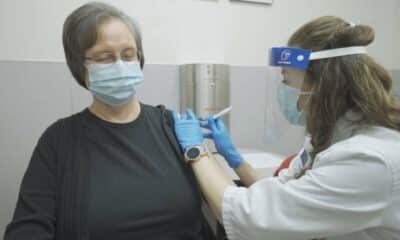Mississippi Today
Is Gov. Tate Reeves correct with ‘record jobs’ claim? Depends on which data you pull.

Gov. Tate Reeves proudly proclaims in a campaign advertisement that “more of our people are working in Mississippi than ever before.”
That statement running on local television stations would be true for most states, but not necessarily so for Mississippi, according to at least one set of statistics compiled by the U.S. Bureau of Labor Statistics.
Based on one jobs report produced by BLS, the federal agency that tracks employment data, Mississippi reached a high-water mark for jobs in May 2000 with 1,243,022 people employed. In May 2023, the state had 1,206,804 people working, about 5,000 fewer than a month earlier — though those latest two months of jobs numbers are subject to revision.
Based on another jobs report compiled by BLS using different data, the governor is correct when he says more people are working than ever before. According to that data, Mississippi reached an all-time employment level high of 1,178,700 jobs in May, up about 300 jobs from April.
The difference in reports depends on varying models used by BLS researchers. The unemployment rate released each month is developed using data from the Current Population Survey and does not count people working multiple jobs, but does count self-employed workers, workers on leave, agriculture workers and others.
In the other BLS model, though, if a person is working two jobs, it counts both jobs in the total. But the model, the Current Employment Statistics, does not count self-employed workers, workers on leave, agriculture workers and others.
But even using the non-farm data that shows the state currently at its peak employment numbers, Mississippi still ranks 50th in jobs growth since 2000, based on information compiled by Arizona State University's Seidman Research Institute.
At any rate, using various metrics, Mississippi has not exceeded the jobs growth of the rest of the nation since the COVID-19 pandemic. The United States regained all the jobs lost during the pandemic in July 2022. Mississippi already was losing jobs by the time the pandemic hit in early 2020. The state hit a high mark in non-farm payroll in November 2019 with 1,170,900 jobs and did not surpass that number again until September 2022.
According to BLS, using the non-farm category, Mississippi added 16,600 jobs from May 2022 to May 2023, or a 1.4% increase. That placed Mississippi among the bottom eight states in terms of jobs growth.
Rhode Island was the only state that had more jobs in May 2022 than a year later, according to BLS, using the non-farm, payroll data.
Without a doubt, the health of the Mississippi economy will be a major issue during this year's gubernatorial campaign between the incumbent Republican Reeves and Democratic challenger Brandon Presley. And numbers can be manipulated to prove various arguments.
“Mississippi is open for business and our state is growing stronger every day. This is Mississippi's time,” the governor said on social media.
But Presley has said, “Mississippi is at the bottom of the nation for economic growth.”.
Who is right? That will be much discussed before Mississippians go to the polls in November.
Reeves is celebrating the fact that Mississippi has a historically low 3.2% unemployment rate for the month of May and highlighting three consecutive months the state had set records for lowest unemployment rates.
The national unemployment rate was 3.7% in May — the highest since October 2020. But the national unemployment rate for multiple months is still historically low for the modern era. The lowest on record of 2.5% occurred in 1953.
The unemployment rate reflects the number of people looking for a job.
Many believe the labor force participation rate, which reflects the number of people eligible to work who are employed, is a more accurate reflection of economic well-being.
Mississippi continues to trail the nation in the labor force participation rate. Mississippi's and West Virginia's seasonally adjusted labor force participation rates of 54.6% in May were the lowest in the nation. The national average for May was 62.6% — the highest since before the pandemic.
Mississippi's best labor force participation rate in the modern era of 62.8% occurred in early 2000, when the state hit its zenith in terms of employment, according to at least one Bureau of Labor Statistics measurement category.
This article first appeared on Mississippi Today and is republished here under a Creative Commons license.
Mississippi Today
Renada Stovall, chemist and entrepreneur
Renada Stovall sat on the back deck of her rural Arkansas home one evening, contemplating life when she had a life-altering epiphany…
“I gotta get out of these woods.”
She heard it as clear as lips to her ear and as deep as the trees surrounding her property. Stovall's job as a chemist had taken her all over the country. In addition to Arkansas, there were stints in Atlanta, Dallas and Reno. But she was missing home, her parents and friends. She also knew, she needed something else to do.
“I thought, what kind of business can I start for myself,” said Stovall, as she watered herbs growing in a garden behind her south Jackson home. Some of those herbs are used in her all-natural products. “I know when I lived in Reno, Nevada, where it's very hot and very dry, there really weren't products available that worked for me, my hair, and my skin suffered. I've got a chemistry degree from Spelman College. I took the plunge and decided to create products for myself.”

In 2018, Stovall's venture led to the creation of shea butter moisturizers and natural soaps. But she didn't stop there, and in December 2022, she moved home to Mississippi and got to work, expanding her product line to include body balms and butters, and shampoos infused with avocado and palm, mango butter, coconut and olive oils.
Nadabutter, which incorporates Renada's name, came to fruition.

Stovall sells her balms and moisturizers at what she calls, “pop-up markets,” across the state during the summer. She's available via social media and also creates products depending on what of her ingredients a customer chooses. “My turmeric and honey is really popular,” Stovall added.
“The all-natural ingredients I use are great for conditioning the skin and hair. All of my products make you feel soft and luscious. The shea butter I use comes from West Africa. It's my way of networking and supporting other women. And it's my wish that other women can be inspired to be self-sufficient in starting their own businesses.”





This article first appeared on Mississippi Today and is republished here under a Creative Commons license.
Mississippi Today
On this day in 1954
MAY 17, 1954

In Brown v. Board of Education and Bolling v. Sharpe, the U.S. Supreme Court unanimously ruled that the “separate but equal” doctrine in Plessy v. Ferguson was unconstitutional under the 14th Amendment, which guaranteed equal treatment under the law.
The historic decision brought an end to federal tolerance of racial segregation, ruling in the case of student Linda Brown, who was denied admission to her local elementary school in Topeka, Kansas, because of the color of her skin.
In Mississippi, segregationist leaders called the day “Black Monday” and took up the charge of the just-created white Citizens' Council to preserve racial segregation at all costs.
This article first appeared on Mississippi Today and is republished here under a Creative Commons license.
Mississippi Today
Every university but Delta State to increase tuition this year
Every university in Mississippi is increasing tuition in the fall except for Delta State University.
The new rates were approved by the governing board of the eight universities, the Institutions of Higher Learning Board of Trustees, at its regular meeting Thursday.
The average cost of tuition in Mississippi is now $8,833 a year, a roughly 3% increase from last year. Students can expect to pay tuition ranging from $7,942 a year at Mississippi Valley State University to $10,052 a year at Mississippi State University.
In recent years, universities have cited inflation and rising insurance costs as reasons for the tuition increases. At Thursday's meeting, the board heard a presentation on how property insurance is becoming more expensive for the eight universities as Mississippi sees more tornadoes and storms with severe wind and hail.
READ MORE: Tuition increases yet again at most public universities
But it's an ongoing trend. Mississippi's public universities have steadily increased tuition since 2000, putting the cost of college increasingly out of reach for the average Mississippi family. More than half of Mississippi college students graduated with an average of $29,714 in student debt in 2020, according to the Institution for College Access and Success.
At Delta State University, the president, Daniel Ennis, announced that he will attempt to avoid tuition increases as the regional college in the Mississippi Delta undergoes drastic budget cuts in an effort to become more financially sustainable.
“We will resist tuition increases so that our most economically vulnerable students can continue to have access to the opportunities that a college degree can provide,” he wrote in a memo to faculty and staff on Monday. “We will move beyond basic survival and into a place where we have the capacity to take better advantage of our undeniable strengths.”
Delta State didn't increase tuition last year, either. Officials have been concerned the university is becoming too pricey for the students it serves.
Tuition for the 2024-25 academic year, by school:
- Alcorn State University: $8,105
- Delta State University: $8,435
- Jackson State University: $8,690
- Mississippi State University: $10,052
- Mississippi University for Women: $8,392
- Mississippi Valley State University: $7,492
- University of Mississippi: $9,612
- University of Southern Mississippi: $9,888
This article first appeared on Mississippi Today and is republished here under a Creative Commons license.
-
SuperTalk FM5 days ago
Martin Lawrence making 3 stops in Mississippi on comedy tour
-
Our Mississippi Home4 days ago
Beat the Heat with Mississippi’s Best Waterparks
-
Our Mississippi Home4 days ago
Charlie’s U-Pik: Opening Soon for the Summer Season
-
Mississippi News Video7 days ago
Local dentists offer free dental care in Amory
-
Kaiser Health News4 days ago
Medicaid ‘Unwinding’ Decried as Biased Against Disabled People
-
Mississippi News Video3 days ago
Jackson has a gang problem
-
SuperTalk FM15 hours ago
State auditor cracking down on Mississippians receiving unemployment benefits
-
Mississippi Today7 days ago
On this day in 1968









































